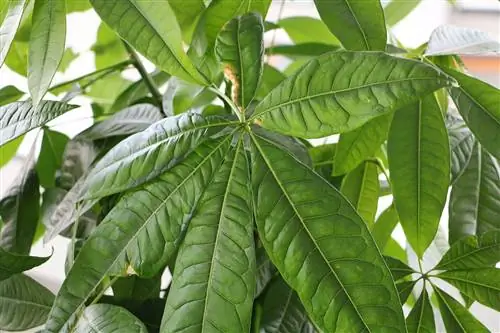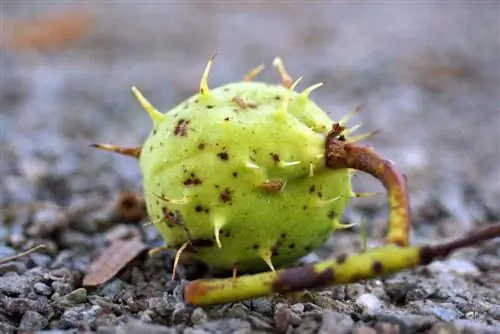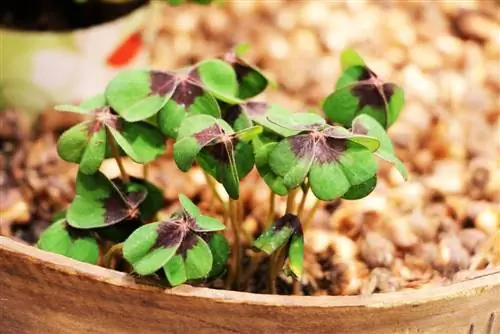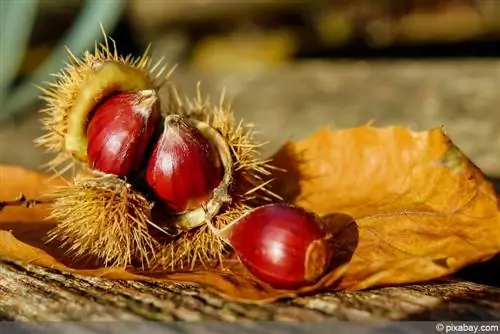- Author admin [email protected].
- Public 2023-12-17 03:39.
- Last modified 2025-01-24 12:45.
Pachira aquatica is known by many names. The plant is called the shaving brush tree because of its showy flowers. Anyone who successfully cultivates this exotic plant can enjoy a tropical atmosphere.
Profile
- original home extends from Mexico to the north of Brazil
- evergreen deciduous tree that grows up to 20 meters high
- also known as Guyana, wild cacao tree or Malabar chestnut
- Flowers greenish yellow to cream colored with red stamens reminiscent of shaving brushes
- Bats are probably natural pollinators
Location and soil
The lucky chestnut prefers bright conditions and does not like direct sunlight. She feels comfortable on the south-facing windowsill if she is shaded by a curtain at lunchtime. Ideally, you should place the lucky tree in a west or east window. The ornamental plant finds optimal conditions when the thermometer is between 18 and 20 degrees in summer. If the room air is warmer than 25 degrees, you should increase the humidity. During the summer months, the ornamental chestnut tolerates an outdoor location as long as the place is protected from wind and rain and in shade. The substrate should meet the following properties:
- loose and permeable with a high sand content
- pronounced ability to store water without promoting waterlogging
- high proportion of nutrients
- potting soil, container plant substrate or cactus soil are ideal
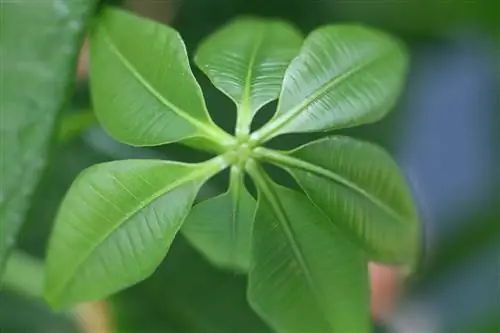
Pouring
The lucky tree develops a slightly thickened trunk base, which is made up of so-called buttress roots or root approaches. These structures not only provide stability but also water storage. This means that the plant does not require a lot of water, although regular irrigation makes sense. This is the only way the storage can fill up again. Use lime-free rainwater to prevent unsightly stains on leaves and bark. How to water correctly:
- irrigate thoroughly once a week in summer
- pour away excess water
- Let the substrate dry before the next watering
- water rarely in winter so that bale does not dry out completely
- Spray leaves regularly throughout the year
Fertilize
You do not need to fertilize the room chestnut in its first year as the plant is supplied with sufficient nutrients in stores. From the second year onwards, the effort required for care increases, because the ornamental chestnut then values a regular supply of nutrients during the main growing season. In winter, the need for nutrients decreases as the plant takes a break. Follow this procedure to promote the tree's vitality:
- fertilize every two weeks between April and September
- Use commercial flower or green plant fertilizer in half concentration
- Add liquid fertilizer to the irrigation water and administer with the usual watering
Cutting
The lucky chestnut does not require any pruning. If wilted leaves do not fall off on their own, you can pick them off by hand. If the plant takes up too much space over time, pruning measures are possible all year round. Ideally, temperatures are above 20 degrees so that the plant can sprout again quickly. Trim the tree to the desired size using sharp pruning shears. After about two weeks, fresh shoots will develop below the cut sites.
Note:
Unfavorable lighting conditions mean that the shape of the shaving brush tree no longer develops as evenly as before. Plant lamps provide good lighting.
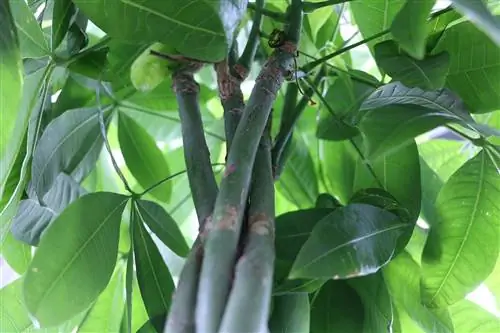
Wintering
The tree hibernates in a bright and cool winter quarters. An unused room with windows or a winter garden provides optimal conditions for unproblematic winter rest. During the cold season, the indoor chestnut tolerates slightly cooler conditions, which should not fall below twelve degrees for a long period of time. Temperatures of less than ten degrees Celsius can damage the plant. The humidity should be between 40 and 50 percent. Check the leaves and trunk regularly for pests so that you can act quickly.
Repotting
Every two to three years, the lucky chestnut requires a new pot so that its roots can spread freely. If the soil is leached early and heavily compacted so that the water simply runs through the edges of the pot, repotting is also advisable. The plant looks better in taller planters, although it does not place any special demands on the quality of the pots. If you choose a container with an irrigation system, regular watering is no longer necessary. How to proceed:
- Get the root ball out of the old pot
- Tamp out the substrate completely
- cut off rotten roots
- Place drainage made of stones or pottery shards in the new pot
- Fill the floor with fresh substrate
- Insert the tree and fill the gaps with soil
- Press the substrate and water thoroughly
Tip:
Repot Pachira aquatica in a fresh container immediately after purchase, as the containers do not offer enough space. You can use this opportunity to unbraid braided items and remove elastic bands to avoid pressure points.
Hydroculture
The lucky tree is suitable for hydroponics, which is recommended for plants in offices. With this variant there is no need for regular watering. Hydroponics is not suitable as a permanent form of cultivation because the plants wither after about a year due to a lack of nutrients. Because moving from soil to a soil-free rooting environment often causes problems, you should choose to purchase a hydroponic-grown plant. The following aspects provide initial clues for successful cultivation:
- Expanded clay or coarse lava gravel is suitable as a substrate
- this can dry out between waterings
- fertilized with mineral fertilizer that is suitable for hydroponics
- Nutrient solution administered at each refill
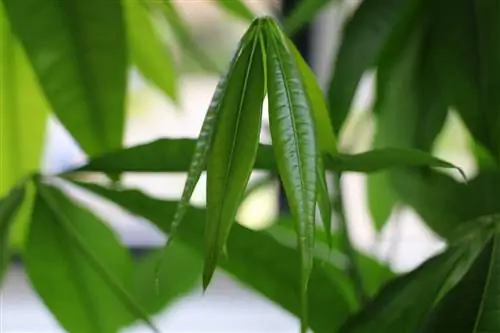
Cuttings
Pachira aquatica is easily propagated from cuttings that you cut before the start of the new growing season. You can use both woody and green shoots, with the fresh parts of the plant forming roots more quickly. Place the cuttings in a glass of lukewarm water and place it in a warm and bright place. As soon as the first root tips appear at the interface, you can plant the young plant.
Tip:
You can also place the cuttings directly in a planter filled with substrate. Dust the dried interface with a rooting powder beforehand to accelerate root formation.
Sowing
In indoor cultivation, the shaving brush tree does not produce any fruit because the important pollinators are missing. The capsules are woody and weigh about 1.5 kilograms. They contain ten to 25 round seeds, which are surrounded by a spongy fruit casing. You can occasionally find seeds of this plant in well-stocked garden stores. The best time for sowing is spring. By following the correct approach you can increase germination success:
- Soak seeds in lukewarm water for 24 hours
- Mix seed soil with sand or perlite and fill into a container
- Plant seeds one centimeter deep
- Place the seed tray in a warm place with temperatures of around 23 degrees
- Keep soil moist but not wet
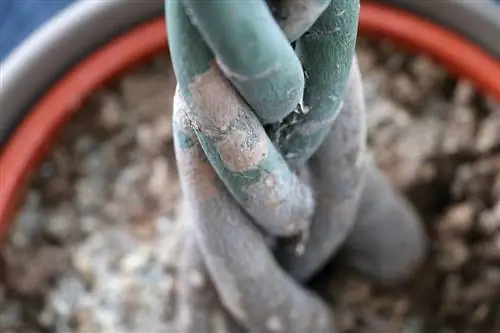
Diseases and pests
Lucky trees are considered robust and rarely suffer from diseases. If the tree has an excessive number of yellow leaves or drops its leaves, the causes are usually incorrect care or incorrect location conditions. A lack of light, drafts and cold or waterlogging are common reasons for leaf discoloration. By changing these conditions, the plant usually recovers over time. However, these pests appear more often when the humidity is too low:
- Spider mites leave behind typical webs
- can be removed by showering
- Mealybugs produce sticky secretions
- an aqueous alcohol solution can be used for spraying

